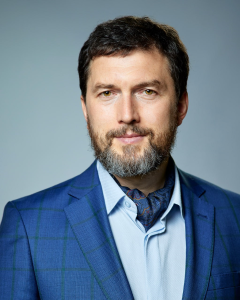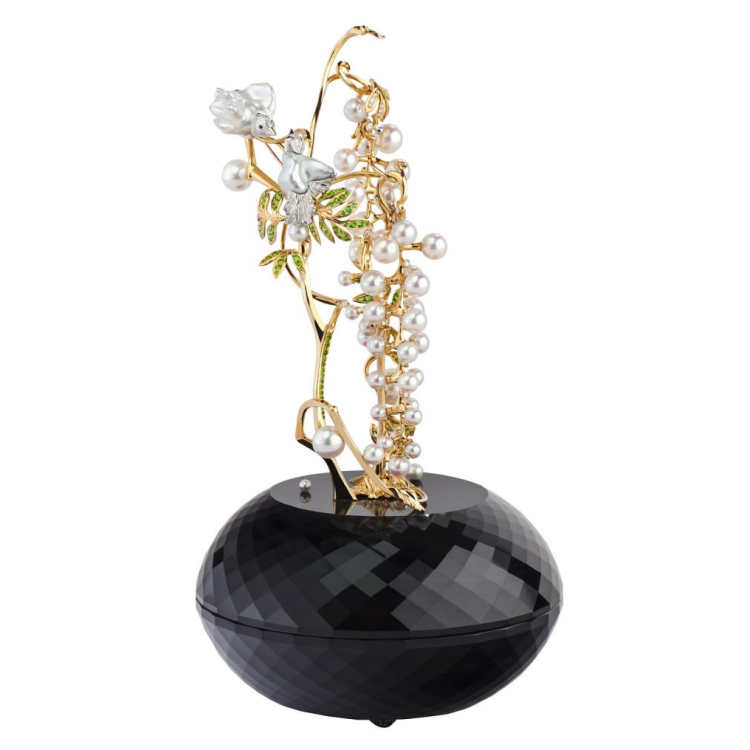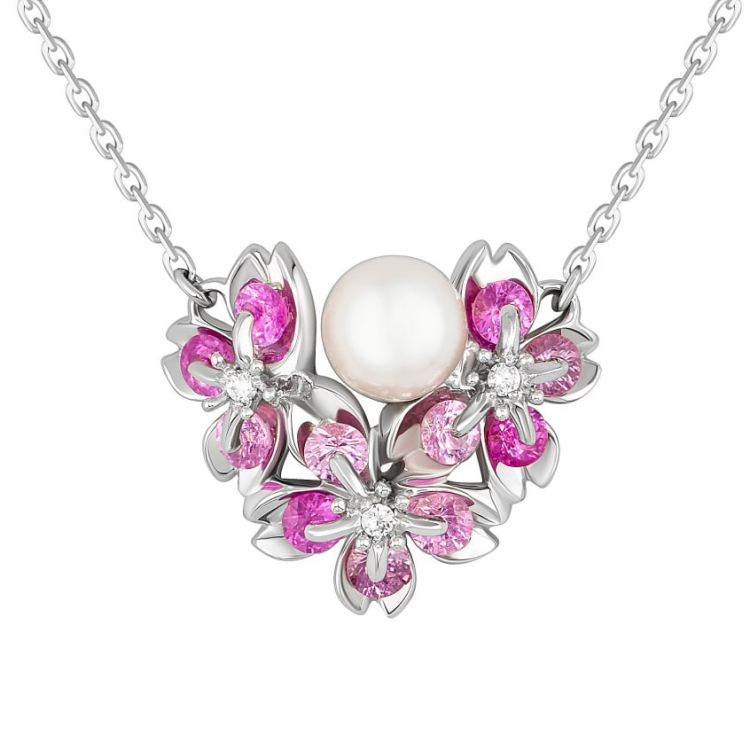 Jewelry items and precious souvenirs of the MOISEIKIN jewelry brand are in the museums and private collections of world celebrities, representatives of the political and cultural elite - from Xi Jinping to the British Windsors, from Angela Merkel to Paco Rabanne, Catherine Deneuve and Jan Zia, as well as the ruling dynasties of the Middle East.
Jewelry items and precious souvenirs of the MOISEIKIN jewelry brand are in the museums and private collections of world celebrities, representatives of the political and cultural elite - from Xi Jinping to the British Windsors, from Angela Merkel to Paco Rabanne, Catherine Deneuve and Jan Zia, as well as the ruling dynasties of the Middle East.Viktor Moiseikin, the founder of the Moiseikin jewelry house and author of several proprietary technologies, including the world-famous unique ‘Russian Setting’ (Waltzing Brilliance), winner of many design awards, told Rough&Polished about the influence of Fabergé, cooperation with auction houses, his new collections and the importance of creative inspiration.
What is the origin of your surname ‘Moiseikin’, especially, taking into account that you are from the Ural area?
My ancestors with the surname ‘Moiseikin’ are actually from the Moscow Region, from the village of Kukarino.
Where do your artistic gift, passion for gemstones, and love for working with precious materials stem from?
Of course, the gift is from above, from the God.
My father was a mining engineer, he was fond of painting and wrote poetry when he was young. My grandfather made furniture and was also good at painting. They were very creative people.
I grew up in the Ural area, and if you live here, you can’t help but like, collect, and admire gemstones. So, all this has its roots in childhood and the first collection of gemstones.
As for Fabergé’s heritage, what is its influence on your works of art?
From my point of view, Fabergé means, first of all, craftsmanship, jewelry art, and diversity of his brilliance. And his top-class excellence as well. His works of art were the source of inspiration for me, probably, during the first 10 to 15 years. There was a desire all the time to add something, add some other meaning - I got carried away and ‘overloaded’ my art works.
But when you keep on improving your attainments, the reverse process begins: you want to remove everything unnecessary. After frequent trips to Japan and due to my passion for the Japanese poetry, I felt an impulse to reach simplicity while keeping emotionality - it happened with the influence of my favorite avant-garde as well.
We recently held an exhibition From Craftsmanship to Art in Bangkok dedicated to the 30th anniversary of our company. Recently, we - like the avant-garde masters - have a desire to find the ‘core’ that is the soul of any art work and a gemstone; a desire to simplify the shape and reduce the number of colors, but to keep a high emotional intensity, as in the Japanese haiku (hokku) poetry. A lot of emotions are of importance - and understatement, muted expression - so that those who look at the piece of art could see themselves in it. This was our approach when we created a new direction, The Music of Color.
Before starting each art work I write poetry to capture the meaning of a would-be jewelry piece and word a strong emotion. The criterion is - if I cannot write a poem, it means that, probably, it’s a far-fetched item that didn’t evoke strong emotions - ‘vibrations’ - in me. And if there are ’vibrations’, it can resonate with the people looking at the work of art, they can feel and understand it.
We have the Harmony of Water collection, and one jewelry piece in it is made of the Burmese rubies and several diamonds. It looks as if the first beam of sunlight is going through the water, and people say, “Oh, sunrise over the sea!”. And it’s so nice that they understand the idea without words.
You cooperate with auction houses such as Sotheby’s, Poly, and others. Can you tell how this happens?
I’m interested in communicating with people working in auction houses - I like to talk to them, hear their opinions on what they chose and why. These meetings, their comments, and criticism are of great value.
I managed to work my way into one auction house that has catalogs for 20-30 years, just to look through them - it’s just a treasure trove of knowledge and a great variety of ideas. You won’t copy the jewelry designs, you just want to see new approaches and discoveries. You look at the catalogs, and the selection criteria becomes clear and your taste is trained, ‘honed’.
Do auction experts have a commercial bias in their perception of jewelry items?
They certainly know and understand their audience, they adapt to it, but the talk is not about commercial jewelry art pieces available in stores.
And this is a real moment of truth - eureka moment - when you can look at yourself through the expert’s eyes. People have been working in this field for 30 years, and their visual experience is amazing.
At auctions, people expect something new, even for investment purposes. When purchasing new jewelry items, collectors sometimes keep the jewelry pieces in safe boxes, and beautiful jewelry art pieces are often displayed in show cases. Buyers at auctions collect valuable family heirlooms as this is beautiful ‘capital’ that can be passed on to her descendants.
Once in Japan, a woman came to my exhibition and bought my transformable floral miniature Wistaria that can be disassembled into several jewelry pieces. She said that she wanted to “leave something behind her”. “The children can sell the house, spend the money - but they will keep this jewelry item bought from a Russian jewelry designer as a memory of me”.
She put the art-work in the show-case next to my photograph, and sent me a photo. It was important for her to leave something beautiful behind her as a message to her descendants, so that they would know how she perceived and understood the beauty.
Certainly, it is interesting to work with auction houses, although, on the one hand, they are commercial companies, and on the other and, buyers at auctions are mainly people who value art and appreciate the beauty of jewelry, and they have a different motivation for consumption.

Have the current sanctions affected the jewelry industry?
They have affected it, but not to the full extent. Art should still stay out of politics and, in my opinion, the art remains a true spiritual value in the Earth’s civilization. The ability to admire something together - flowers, the sky, birds - is essentially what makes us humans and rouses humanity in us. The art that celebrates beauty is a hymn to creation, and a gratitude to it. And with this attitude, there will be more beauty and less wars in the world.
So, ‘the beauty will save the world’, won’t it?
As the saying runs, beauty is in the eye of the beholder.
Recently, I visited the Cindy Chao’s The Art Jewel presentation in Shanghai. I think that now, the center of growth, development, and passion has moved to the Orient, from Europe to Asia. They love beauty, gemstones, a lot of events are held there, including many exhibitions. There are few places where you can see a lot of diversity and so many gemstones, you can always admire the beauty of nature - there is summer all year round. And there is a thrill and drive there. When you look at the ideas of others, you bring forth ideas - life is in full swing there and these places are a hive of activity, including nature, people, the economy - everything. Life is short, and you want to have time to see and express everything.
The poems that I write, help me express myself and also imagine the ‘picture’, word an idea - then the work will be more complete and will definitely resonate with someone.
“Time flows like a river,
Stormy and often fast,
Are we looking for peace
Or the meaning of our life?
We won’t take things with us -
Neither gold, nor diamonds;
We’ll take the light of precious moments,
And the fruits of our talents only”... (word for word translation – ed.)
The number of ideas coming during the day is so great that the people around get upset, “What, again?” Many people want stability, but I want the development, discovering something, including discovering myself. The world around us is wonderful, and there is so much unknown in life, and I want to realize my artistic vision.
Your invention patents demonstrate your practical, technical and engineering mind. How does this coexist with poetry?
I was lucky that I studied at the Faculty of Mechanical Engineering, made drawings of various gears... All this helps me now.
Many jewelry designers and artists wanted to fill the material with ‘life’. And it is very important for me that there is life in any art-work. How can you achieve that a jewelry piece made from solid material could have a ‘sense of life’ and its movement, so that the shimmering colors of art piece could instantly catch the eye of people?
Why are discoveries made, new technologies created, and patents obtained to protect them? There is some interesting idea that you want to express as clear as possible.
You can do something classic: draw a shape, make something simple. But if you want to create a collection related to space, you look for a different form - something out of this world. Technical ideas are not needed per se, they are required just to realize a new idea. This is how the Russian Setting was created to show a moving flower, its life, the play of light... I also love optical illusions – when a gemstone reflects in another gemstone to show the movement of color, a combination of colors, their influence on each other, to get the feeling how the light is moving towards you or from you - what Kandinsky loved and explored...
In my new line - GemsCouture - I want to show all the beauty of colored gemstones having a simple shape, to highlight the saturation and play of a color. Using a combination of colors, sometimes hard (but one should be very careful), often in the form of a background color, I want to further enhance the beauty of, say, a red ruby or royal blue sapphire. Each gemstone has its own color, its own shape. If it’s a cushion-cut gemstone, it is with corners. I have now the inspiration to express mood, I do my best to make styles for all the gemstones to express some idea, concept, for example, Lotus Flower or Color Dance, or the image of a star shining in the night sky. I want to choose an image for each gemstone based on its color and shape.
This year, we completed the Sakura Waltzing with the Wind collection. There are six art-works, but there will be more because I want to continue the collection. My last visit to Japan was in the sakura blossom season - there are more than 200 types of Oriental cherry trees: there are night sakura trees, as well as green sakura trees...

For the Japanese, not just beauty is important: on the one hand, it is admiration, and on the other hand, it’s a ‘farewell’ as the joy and sadness coexist and help to better feel the beauty of the moment. The moment can reflect the whole life. And the sakura blossoms is perceived differently each time: the end and the beginning of sakura blossoming are different. You can see the sakura trees near the water, its petals cover the entire water surface, they are on water and reflected in it, and it is not clear what petals are alive and what peals are the reflection in the water.
This feeling of meeting and a ‘farewell’ at the same time inspired me very much: the sakura trees were just beginning to bloom, and I abandoned diamonds in the line for young girls, and left only the color of the flower buds not to spoil it with glitter.
And the other sakura tree, already in blossom, is large, and the size of the jewelry item is larger, its color is more saturated and brighter, it is for a woman.
Contrasts generally evoke maximum emotions, how to convey a meeting and a ‘farewell’ so that a feeling of pleasant sadness - a mixture of joy and sadness - could remain?
We are also lucky that we work with ‘imperishable’, almost eternal materials. The history of the Earth’s civilization can be seen through jewelry pieces: they last for centuries and can tell a lot about the people who created and wore them.
It’s a real responsibility. In Japanese gardens, you can see how a designer thought about them both in space, and in time, because a 10-year tree ‘fits in’ with the landscape. I would like the jewelry art pieces to last as well. Sometimes, I ‘age’ the gold to make it look like it would look in a few years. This ‘vintage’ feeling was in my Vincent collection: the jewelry pieces looked as if they were 20 years old - with a gold’s subdued tone of color, with a patina effect, as well as with Japanese wabi-sabi, the simplicity of antiquity, and the story of a life spent. The main thing is that the jewelry art pieces are meaningful and evoke emotions, so that they are not just industrial products. Much is true in the opinion that the West turns everything into business, and the Orient - into art. In general, Asia is closer to nature, to the ‘roots’.
All this luxury items – jewelry pieces, a white tiger, a firebird, sakura blossoms... However, let’s come down to earth with its wars, disasters, poverty... How do you manage to distance yourself from all this? Is there a desire to reflect something more earthly?
I often think that we are taught to show compassion to someone, to feel empathy, but we are not taught to admire flowers and sunsets together, to rejoice at someone’s happiness - most people don’t know how to do this.
I don’t remember who said these words, “If you look at the stars, of course, you won’t reach them, but you will see less dirt on the earth.” You always notice dirt, just look down. The dirt is poured out on us in a huge stream - just turn on the TV.
This is reflected in many of the works of modern designers.
I love looking at flowers and stars. I just want to see and create beauty - a feeling of harmony is important to me to make my heart sing for joy. You don’t have to buy any jewelry items, but I would like that when you look at our Sakura Waltzing with the Wind, you would like to get to know and read more about it, go into the country to enjoy the nature or to the Botanical Garden to admire the flowers, and be in harmony with nature.
Galina Semyonova for Rough&Polished
